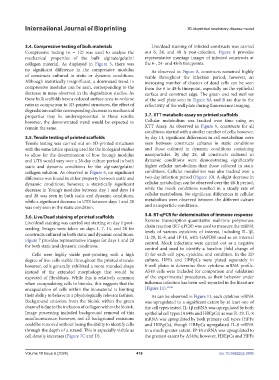Page 426 - IJB-10-6
P. 426
International Journal of Bioprinting 3D-bioprinted respiratory disease model
3.4. Compressive testing of bulk materials Live/dead staining of infected constructs was carried
Compressive testing (n = 12) was used to analyze the out 6, 24, and 48 h post-infection. Figure 8 provides
mechanical properties of the bulk alginate/gelatin/ representative montage images of infected constructs at
collagen material. As displayed in Figure 5, there was the 6-, 24- and 48-h timepoints.
no significant difference in the compressive modulus As observed in Figure 8, constructs remained highly
of constructs cultured in static or dynamic conditions. viable throughout the infection period; however, an
Although statistically insignificant, a downward trend in increasing number of clusters of dead cells can be seen
compressive modulus can be seen, corresponding to the from the 6 to 48-h timepoint, especially on the epithelial
decrease in mass observed in the degradation studies. As surface and construct edge. The green and red outlines
these bulk scaffolds have a reduced surface-area-to-volume of the well plate seen in Figure 8A and B are due to the
ratio in comparison to 3D-printed structures, the effect of reflectivity of the well plate during fluorescence imaging.
degradation and the corresponding decrease in mechanical
properties may be underrepresented in these results; 3.7. XTT metabolic assay on printed scaffolds
however, the demonstrated trend would be expected to Cellular metabolism was tracked over time using an
remain the same. XTT Assay. As observed in Figure 9, constructs for all
conditions started with a similar number of cells; however,
3.5. Tensile testing of printed scaffolds by day 14, significant differences in cell metabolism were
Tensile testing was carried out on 3D-printed structures seen between constructs cultures in static conditions
with the same lattice spacing used for the biological studies and those cultured in dynamic conditions containing
to allow for the determination of how Young’s modulus nanoparticles. By day 28, all constructs cultured in
and UTS would vary over a 28-day culture period in both dynamic conditions were demonstrating significantly
static and dynamic conditions for the alginate/gelatin/ higher cellular metabolism than those cultured in static
collagen solution. As observed in Figure 6, no significant conditions. Cellular metabolism was also tracked over a
difference was found in either property between static and two-day infection period (Figure 10). A slight decrease in
dynamic conditions; however, a statistically significant cellular metabolism can be observed over the 48-h period,
decrease in Young’s modulus between day 1 and days 14 while the mock conditions resulted in a steady rate of
and 28 was seen in both static and dynamic conditions, cellular metabolism. No significant differences in cellular
while a significant decrease in UTS between days 1 and 28 metabolism were observed between the different culture
was only seen in the static condition. and nanoparticle conditions.
3.6. Live/Dead staining of printed scaffolds 3.8. RT-qPCR for determination of immune response
Live/dead staining was carried out starting on day 1 post- Reverse transcription-quantitative real-time polymerase
seeding. Images were taken on days 1, 7, 14, and 28 for chain reaction (RT-qPCR) was used to measure the mRNA
constructs cultured in both static and dynamic conditions. levels of various cytokines of interest, including IL-1β,
Figure 7 provides representative images for days 1 and 28 IL-29, IL-8, and IP-10, with GAPDH used as an internal
control. Mock infections were carried out as a negative
for both static and dynamic conditions.
control and used to identify a baseline (fold change of
Cells were highly viable post-printing with a high 1) for each cell type, cytokine, and condition. In the 2D
degree of live cells visible throughout the printed strands; culture, HPFs and HBEpCs were plated separately in
however, cells generally exhibited a more rounded shape 6-well plates to determine their cytokine mRNA profile.
instead of the extended morphology that would be A549 cells were included for comparison and validation
expected of fibroblasts. While this is relatively common of the experimental procedures, as their behavior under
when encapsulating cells in bioinks, this suggests that the influenza infection has been well-reported in the literature
encapsulation of cells within the biomaterial is limiting (Figure 11). 48-50
their ability to behave in a physiologically relevant fashion. As can be observed in Figure 11, each cytokine mRNA
Background emission from the bioink within the green was upregulated to a significant extent by at least one of
channel is due to the inclusion of collagen within the bioink. the cell types tested. IL-1β mRNA was upregulated by both
Image processing included background removal of this epithelial cell types (A549s and HBEpCs) as was IL-29. IL-8
autofluorescence; however, not all background emissions mRNA was upregulated by both primary cell types (HPFs
could be removed without losing the ability to identify cells and HBEpCs), though HBEpCs upregulated IL-8 mRNA
through the depth of a strand. This is especially visible as to a much greater extent. IP-10 mRNA was upregulated to
cell density increases (Figure 7C and D). the greatest extent by A549s; however, HBEpCs and HPFs
Volume 10 Issue 6 (2024) 418 doi: 10.36922/ijb.3895

